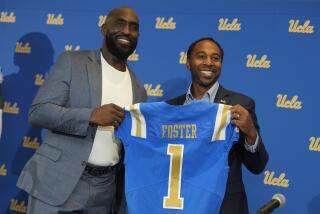Women Athletes Deserve a Chance at College Scholarships, Too : CAMPUS CORRESPONDENCE
- Share via
For a male to win an athletic scholarship, he doesn’t have to be a champion. For a woman athlete, being a champion may not be enough. But legislation recently introduced in Congress would go a long way to ward leveling the scholarship playing field.
Twenty-one years after Title IX, which forbids discrimination on the basis of gender in any school that receives federal funds, became law, women’s sports continue to face discrimination. A 1992 NCAA survey of 253 Division I schools revealed that the average school spends 77% of its operating athletic budget on men’s teams. That leaves slightly more than 20% for women.
But numbers fail to tell the story of those harmed by discriminatory spending patterns. One of Stanford’s finest women soccer players had to transfer to the University of Portland last year because she could not afford to stay at Stanford without an athletic scholarship. Meanwhile, the third-string halfback on the football team continues his education, compliments of the athletic department.
True, many flagrant inequities have disappeared since Title IX passed, and Stanford has been one of the most successful among Division I schools in taking the civil-rights law’s provision seriously. But many schools continue to ignore it--at the expense of women’s programs.
A sport-by-sport comparison in the NCAA survey showed that men’s basketball programs receive almost three times more funding than the women’s basketball programs, despite the fact that the costs--plane tickets, trips, number of games and staff--are identical.
The reason for the discrepancy is not difficult to find. In top Division I schools, football and men’s basketball are the highest-revenue sports, making athletic directors reluctant to trim their budgets. That creates a gap in scholarships not only between men and women, but for other men’s sports as well.
Not having scholarships to offer makes recruiting players more difficult. The NCAA survey indicated that 82.8% of recruiting funds were spent for male athletes. Accordingly, many women choose not to pursue athletics in college. Fewer opportunities discourage aspiring high school athletes, who have fewer role models.
Financial reality cannot be ignored. The point is not that football scholarships should equal those forwomen’s soccer. Rather, the point is that women soccer players should at least be in the running for scholarships. For example, Stanford offers 95 football scholarships. Would the football program unduly suffer if the money allocated for 15 or 20 of those scholarships be used instead to attract women swimmers, or soccer players?
Still, do athletic directors and the NCAA put less money into women’s sports because people don’t like to watch them, thus generating less revenue for the school? Or are these sports less interesting because of the lack of money and attention given to women’s sports?
No one expects a flyweight boxer to step into the ring with a heavyweight, and no one expects every male college basketball player to make it in the NBA. So why should the argument about women’s athletics always boil down to which athlete can bench-press more weight?
Rep. Cardiss Collins (D-Ill.) recently introduced the Equity in Athletics Disclosure Act. The legislation would require all colleges receiving federal funds to disclose their budgets for men’s and women’s athletics and also to provide other basic data to assist the Department of Education in enforcing Title IX. It should quickly become law.
Equality in sports scholarships would not just be a victory for women athletes. It would is a step forward for all who believe in fairness.
More to Read
Go beyond the scoreboard
Get the latest on L.A.'s teams in the daily Sports Report newsletter.
You may occasionally receive promotional content from the Los Angeles Times.










